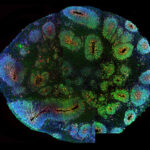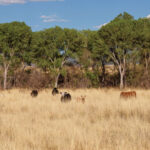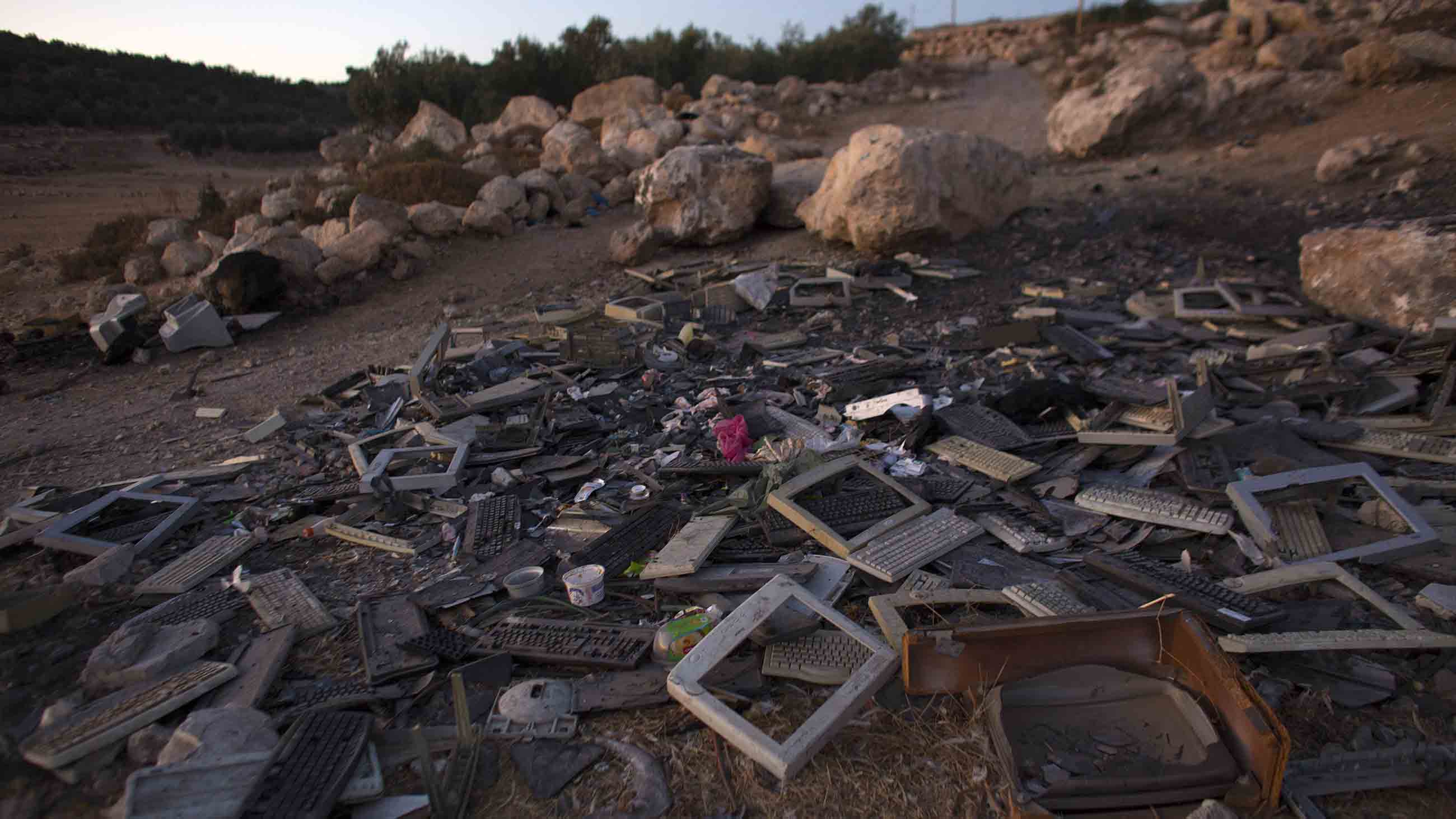Amid Smoldering E-Waste in the West Bank, Activists Fight for Reform
Last November, I was standing in the backyard of a home in the West Bank looking at the fire-blackened pit where a pile of electronic waste had been burned — a lucrative but illegal industry in the region. My guides were an unlikely pair: Sarah Awawdeh, a 36-year-old mother of six in a colorful hijab and clunky, high-heeled boots, who heads a grassroots movement to minimize the health hazards of burning e-waste; and her colleague Yaakov Garb, a researcher at Israel’s Ben-Gurion University who has been examining the practice and impacts of crude e-waste dismantling in the Palestinian Territories for decades.
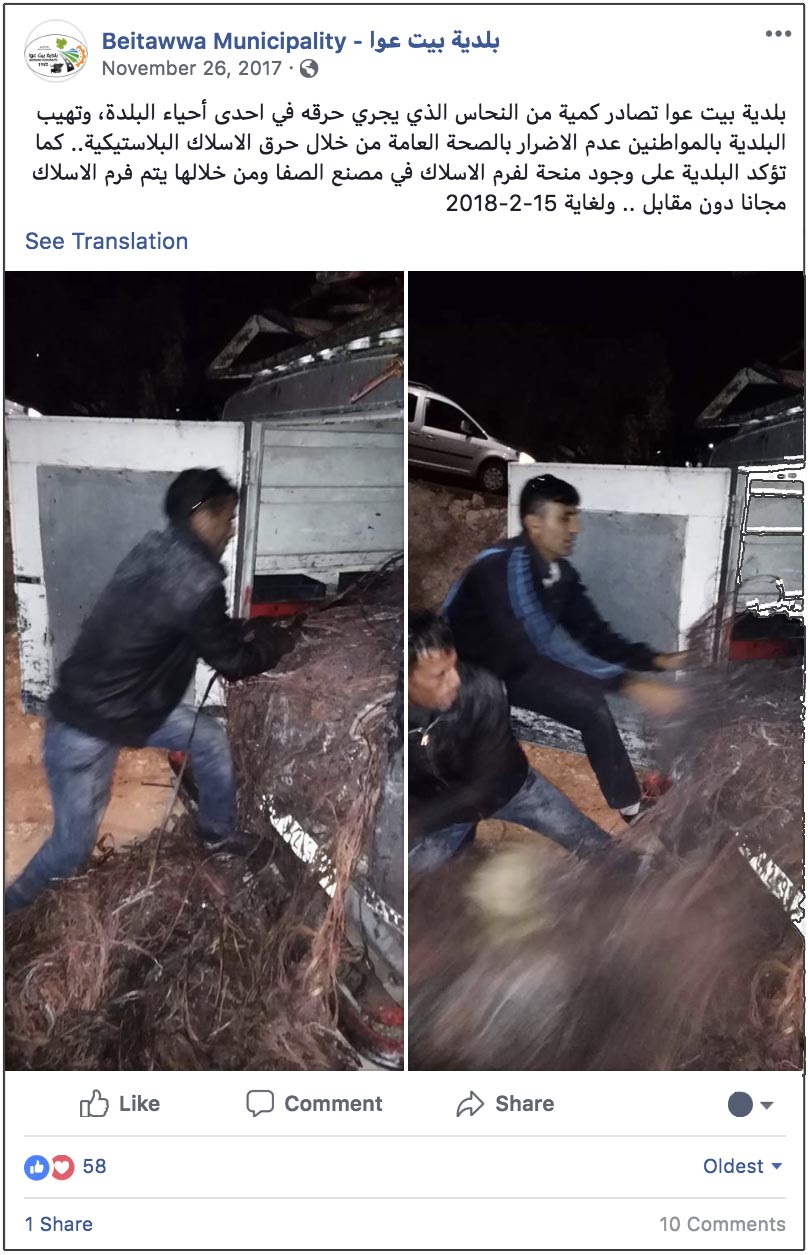
A rapid-response team collects spaghetti-like strands of copper wire that a burner was trying to illegally harvest. The local municipality posted the images on social media.
Visual: Beit Awwa/Facebook
Awawdeh and Garb were showing me the plot of scorched earth where Palestinian men routinely use butane torches and other makeshift tools to dismantle refrigerators, air conditioning units, computers, cables, and other remnants of electronic debris ready for burning. Burning is a crude and prohibited means for extracting copper and other resalable metals embedded in trashed appliances, and over the past two decades, it has become a boom industry in this otherwise stagnant Palestinian region, where Israeli military occupation challenges virtually all forms of development.
As we toured one of the many sooty areas, Awawdeh and Garb spotted thick, black plumes of smoke a mile away, indicating an active burn. We rushed into a dirt-caked truck belonging to the burn response unit, and as the driver sped toward the suspected location in the hills outside the city of Hebron, my hosts phoned their contacts in the Israeli army, requesting passage through a barrier gate between two rural villages. In the high-voltage cat-and-mouse game to catch a burner, every minute is crucial — something the soldiers also understood — and they waved us through.
In under 10 minutes we were at the burn site, just outside the West Bank village of Beit Awwa, and Garb, along with the driver and another member of the frontline response team began shoving the charred, spaghetti-like strands of copper — melted-down, marketable metals from the electric cables found in everything from telephones to switches to lights — into the back of the truck. The municipality would price the copper at thousands of shekels (at least several hundred dollars), but the burner, who later turned out to be a disabled man on the brink of financial ruin, was nowhere in sight.
Such exercises are meant to create a teaching moment, promoting safer, more sustainable alternatives to e-waste burning for the 600,000 people living in the Hebron region of the Palestinian West Bank. The Beit Awwa mayor returned the metals to the disabled man, fined him 1,000 shekels (nearly $300), and had him sign a document saying that in the future, he would bring his cables to the local grinding facility rather than burn them.
On the day it collected the copper, the municipality posted pictures of the material on its Facebook page. “It is the duty of the municipality but, even before that, it is the duty of the average citizen,” the municipality wrote in a comment on the post, “to protect his land, his streets, his home, his children and his family from harm and from diseases, and to create a clean environment.”
In February, the West Bank town of Beit Awwa issued a plea on its Facebook page encouraging residents to help curb the illegal practice of burning e-waste — a toxic but common method used to extract metals for resale on the black market.
E-waste burning near Hebron, in a region that makes up about 20 percent of the West Bank, is a well-documented problem. It occurs mostly on the outskirts of a string of villages to the southwest of the city, beyond the municipal boundaries of the Palestinian Authority and near the concrete barrier that separates the Palestinian West Bank from Israel. Since the Six-Day War of 1967, in which Israel occupied the West Bank and East Jerusalem, much of the land around these villages has been classified as “Area C.” Much of it is privately owned by Palestinians but is subject to direct Israeli military rule. When the Second Intifada hit in the early 2000s and Israel erected a concrete separation wall, fewer Palestinians were granted Israeli work visas, and the local economy became moribund.
For the tens of thousands of Palestinian workers crossing legally or illegally into Israel daily, the early 2000s introduced e-waste burning as a new niche market. “At first, we thought, haram, what a shame for them that Israelis throw all these valuable things away, we do not do that on this side,” Majdi Abu Jhesheh, a 35-year-old former burner, told me. “We started burning as much as we could get our hands on. Then nobody thought, or cared, about the dangers.”
As it stands, only 15 to 20 percent of the world’s 50 million tons of e-waste is recycled, according to a 2017 United Nations University report. The rest is burned, discarded, or dumped in landfills, particularly in impoverished areas of China, Ghana, and India — as well as here in the Palestinian Territories, where day-laborers created a sophisticated black market trucking system, using drivers with Israeli license plates to import Israeli e-waste into the Palestinian Territories, Abu Jhesheh said.
The southwest Hebron area, composed of several clan-run villages connected by barely paved dirt roads, quickly transformed into an extended shantytown. One burner I visited in the West Bank village of Deir Samet used his family’s backyard as a burn site, cramming the once-pastoral setting with the trappings of a makeshift scrapyard: a yellowing, faux-leather couch, an unplugged refrigerator, and a radio affixed to a tree, which played Arabic pop on low volume. In these run-down settings, men and teenage boys — and, for the smaller wires requiring smaller hands, also women and children — dismantle and burn electronics in remarkable quantities.
Area C’s ambiguous geopolitical situation on the borderline between Israeli and Palestinian jurisdictions allowed it to flourish as a Wild West-style boomtown. Burners had little fear of law enforcement and benefitted from the untaxed profits. Several former and current burners told me that burning brought in a monthly income ranging from 10,000 to upwards of 50,000 shekels (roughly $3,000 to $15,000). “Burning is better than selling drugs,” a burner from Deir Samet told me. And it’s much better than most mainstream jobs: According to the Palestinian Central Bureau of Statistics, 16 percent of salaried West Bank Palestinians earn less than the minimum wage of 1,450 shekels ($400) a month, and the unemployment rate there has hovered around 18 percent for years.

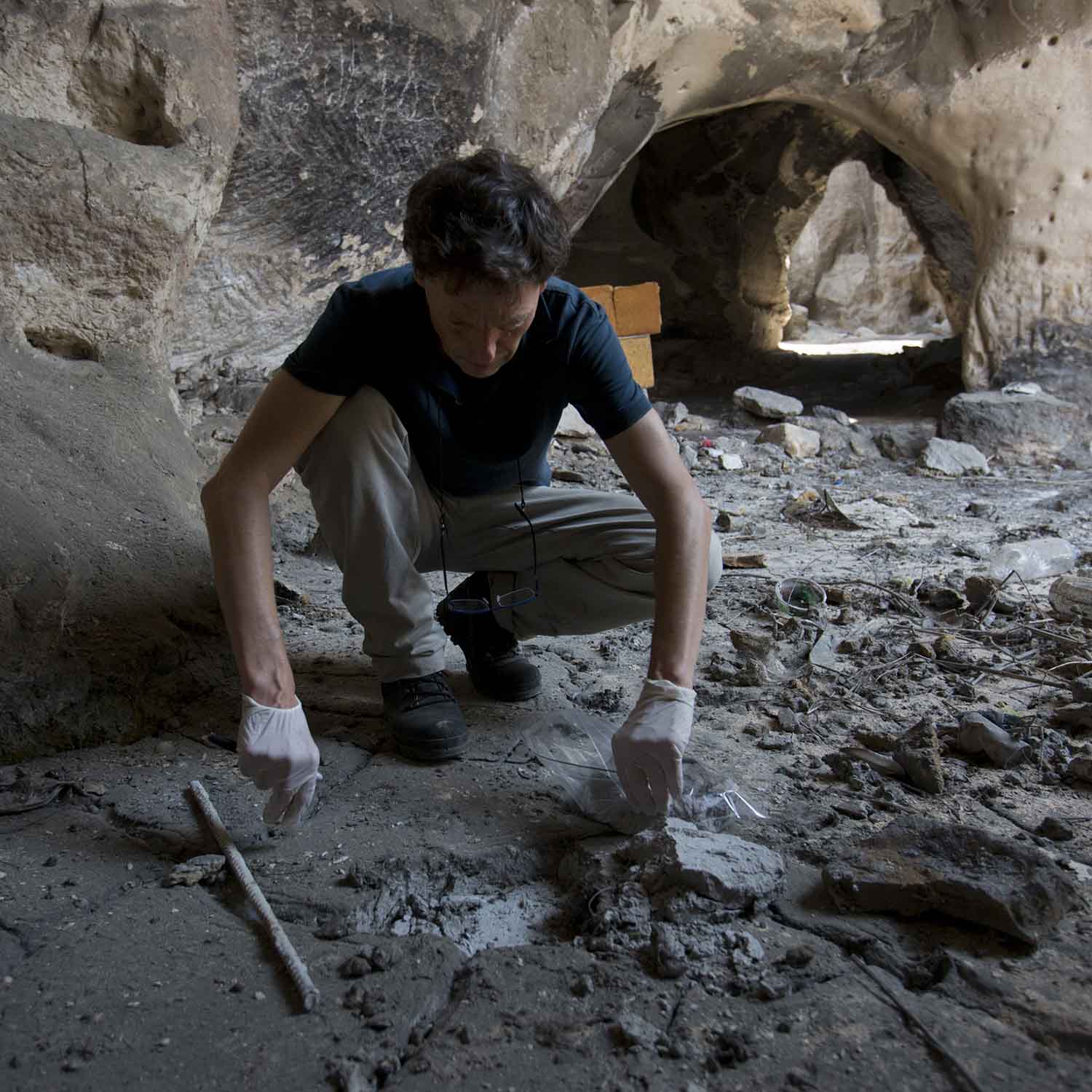
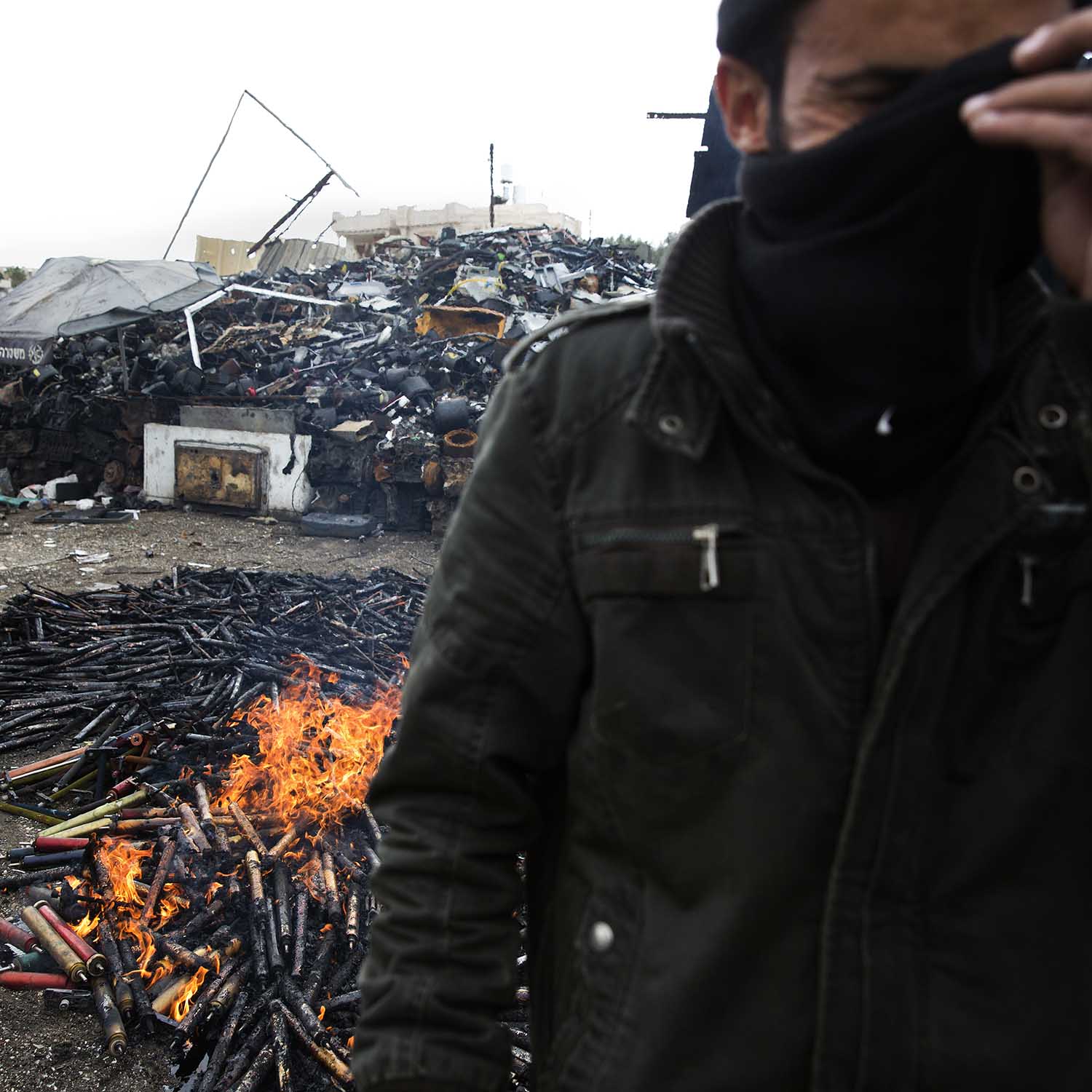
Because the Palestinian Authority that governs parts of the West Bank largely ignored the illegal industry for more than a decade — issuing no labor or health code inspections and technically unable to enforce the law against burners in the Israeli military-occupied territory — burning e-waste has become entrenched.
Moreover, as the Israeli-Palestinian conflict trudges on, e-waste burning follows the political and economic tides. When President Donald Trump announced in December that the U.S. would formally recognize Jerusalem as the Israeli capital — a globally contentious move — residents in the Hebron hills lit up e-waste to cash in on the increased price of copper. (Others burned non-valuable waste like tires in protest.) Tamer Sweity, the manager of the Safa clean recycling facility in the village of Idhna, blames many decades of turmoil and hopelessness, all of which is embodied in the pirate e-waste business, for the often-violent confrontations that Palestinian youths pursue against Israeli soldiers. “Of course, if they have nothing to do, nothing to build for themselves, they will take to throwing stones at the soldiers, [and] to burning e-waste,” he said.
Sweity worked in crude e-waste dismantling before deciding the risks were too high. He made a sharp career pivot and became a nurse at a local clinic, where he was still connected to the e-waste trade, this time as a healer of respiratory infections and other e-waste-related illnesses. He believes that a legitimate e-waste sector — precisely what Awawdeh and Garb and an eclectic mix of activists in the area are trying to build — would be nothing less than “a savior for all of Palestine.”
That’s not a universally held sentiment. Many locals exude a deep distrust of economic empowerment projects of any kind. Muhammad Hroub, a burner from Deir Samet, told me that the Palestinian Authority, the governing body based in Ramallah, has received billions of dollars in international funding but has funneled those funds mostly into Ramallah-based, internationally-oriented NGOs. As Israel marks 51 years of occupying the West Bank territory, peace negotiations, like economic endeavors, have made little progress.
“The PA don’t really want us to live a healthier life, they want our money,” Hroub said, while showing the multiple inhalers he uses to alleviate his asthma. “There’s no one who can’t be paid off, they’re all liars.”
Ahmad Abuthaher, the director general for projects and international relations at the Palestinian Environment Quality Authority said that though 90 percent of Palestinian e-waste originates in Israel, his organization is not planning to implement solutions on imported e-waste as long as Israeli-Palestinian negotiations on cross-border trade remain stagnant. “Israel uses us as their servants so that they can make good money and use our lands as dumping grounds,” he told me.
But Katharina Kummer Peiry, who served as the executive secretary of the Basel convention on hazardous waste, including e-waste, from 2007 to 2012, suggested that the “dumping ground” metaphor was misguided. While many Cold War-era waste laws divide the world into two monolithic blocks — richer, “developed” countries, and the vaguely-defined “developing” countries — that categorization does not apply in the Palestinian Territories, she said. In the West Bank, it is the Palestinians, not the Israelis, who are managing the electronics recycling trade, who have understood its value, and who will be essential to implementing long-term solutions — an understanding that is only now beginning to resonate with the rest of the world.
“With this rising awareness of e-waste’s value, there has been a realization that there might be better ways of dealing with it than to ban it,” Kummer Peiry told me.
“Even if there were the will, it would be impossible to control. Neither the Israelis nor the Palestinians have the manpower,” she added.
Today, a large group of burners still claim that while burning might be dirtier and more hazardous, it’s worth the risk. And at least one burner, Issa Hroub, a cousin of Muhammad Hroub, also of Deir Samet, told me that exposure to the toxic fumes and soot of his e-waste burning was actually good for his three young children. It will “build a strong immune system,” he said.
However misguided those sentiments might seem, they grow out of a truly global market. Observers say that after Palestinians sell the stripped-down metals to the Israelis, the Israelis either use the metals domestically or export them to Europe or to China, which for a number of years had been buying up extracted metals in bulk to support its construction boom.
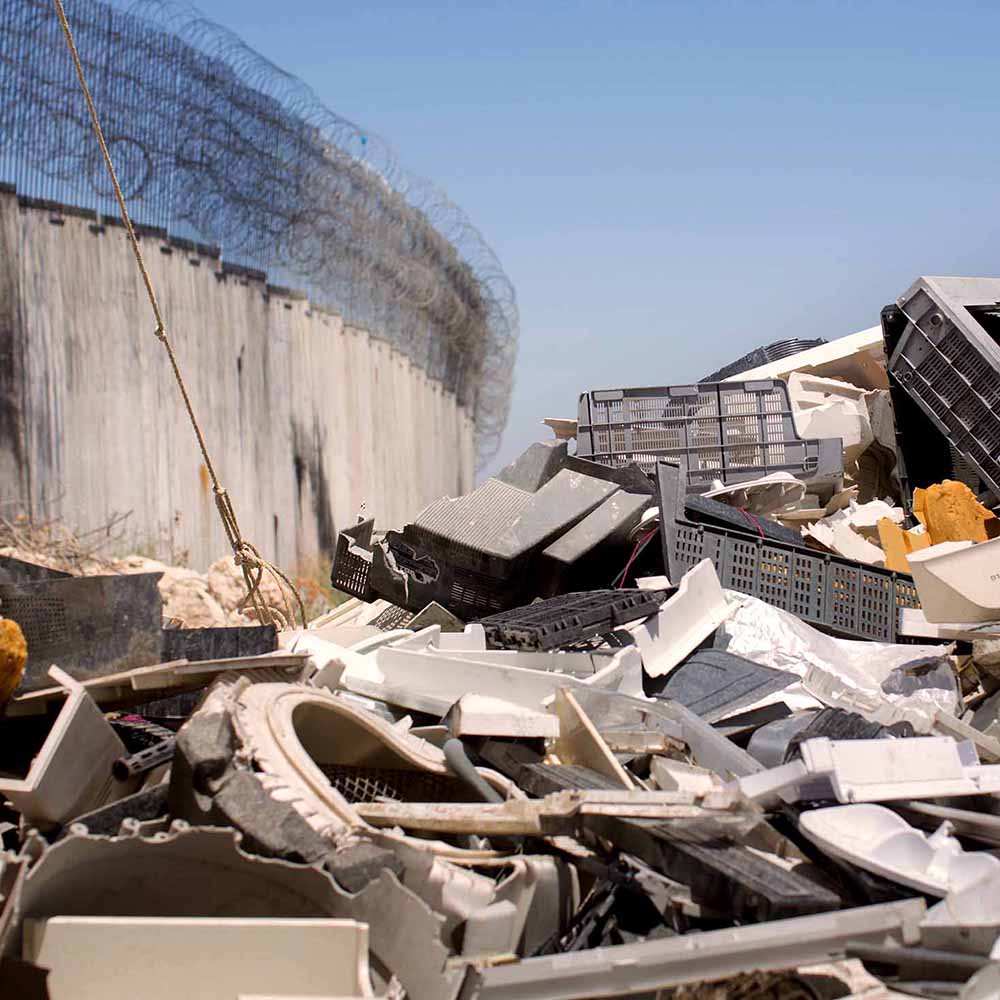
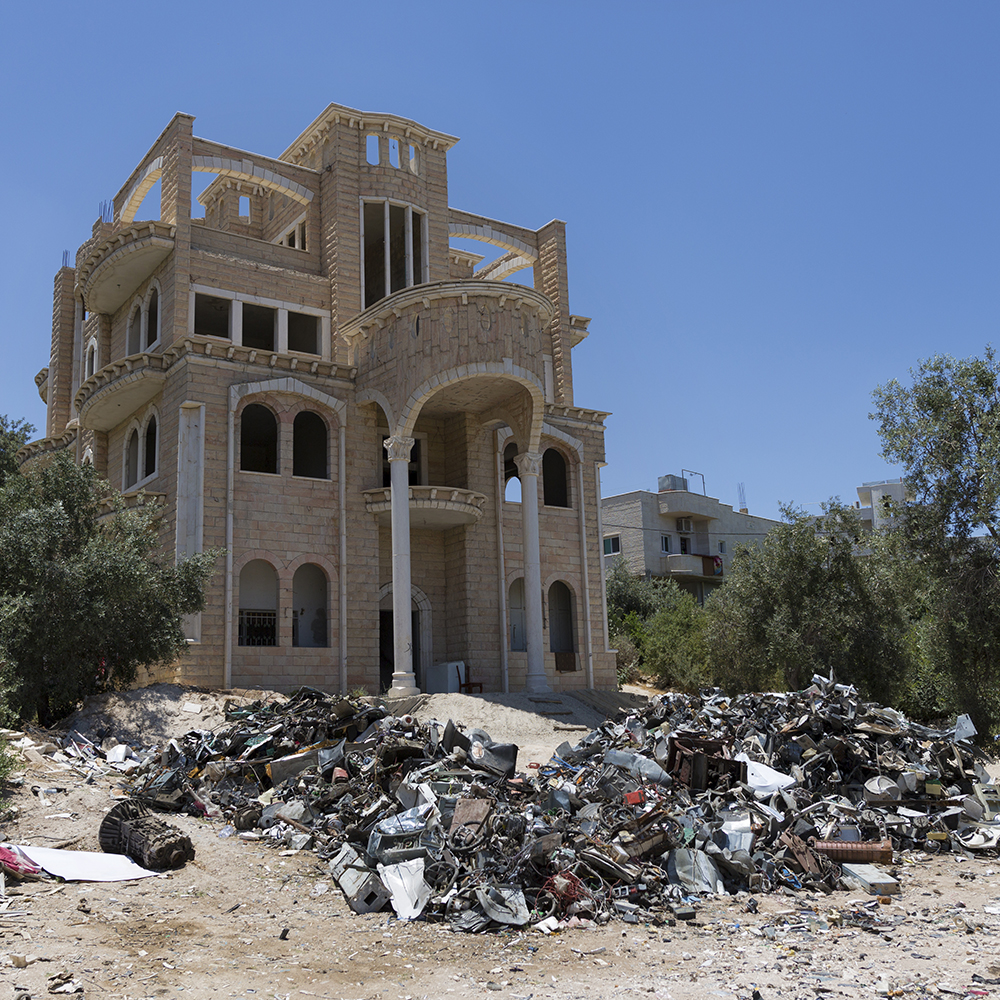
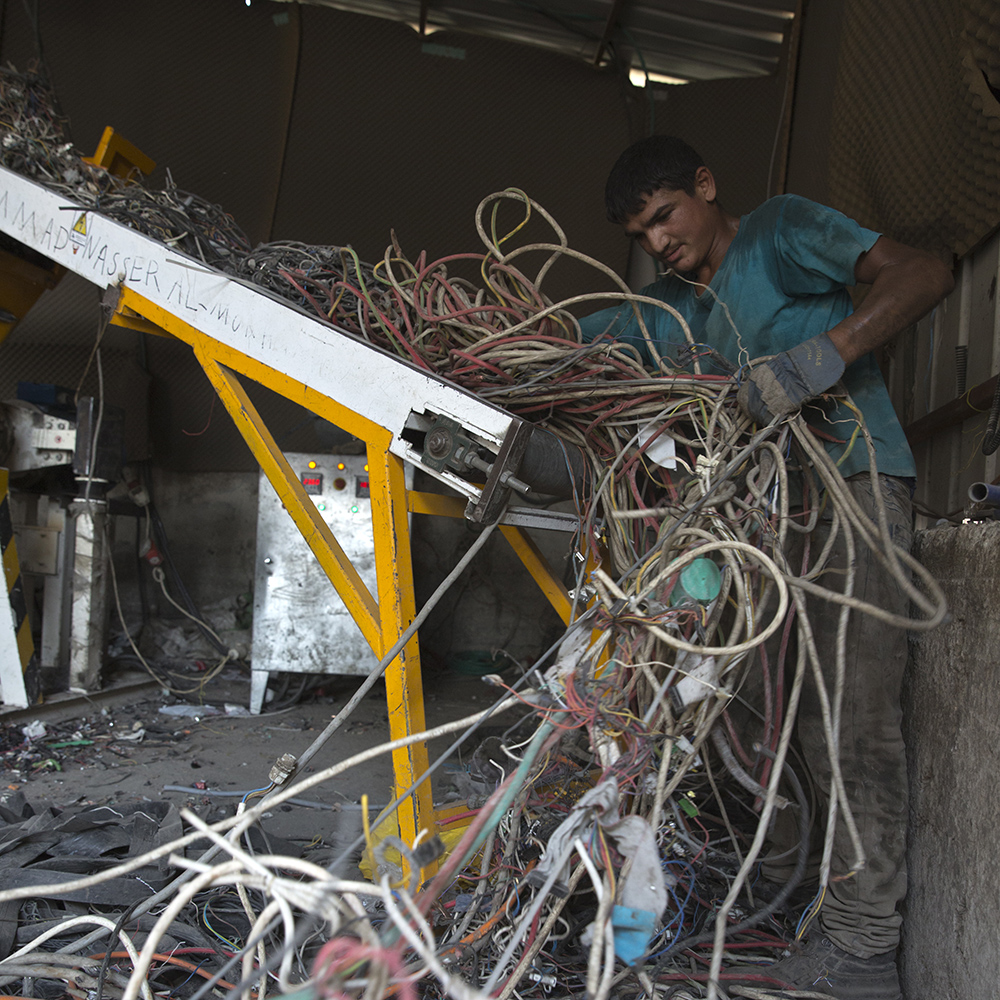
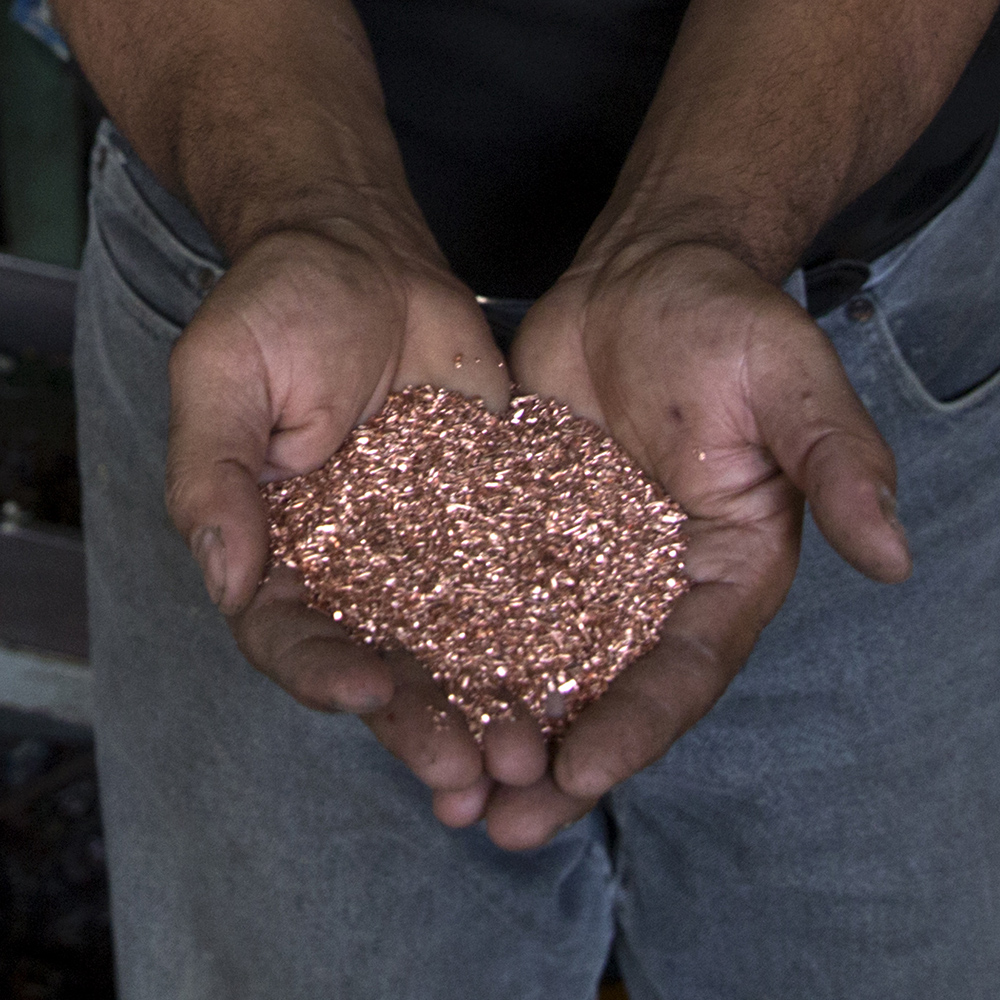
And the e-waste trade is definitely growing. According to a report issued by United Nations University, e-waste is predicted to increase by 17 percent by 2021, making it one of the fastest growing waste streams in the world. Experts agree that the problem of how to re-sell and recycle it safely needs an immediate solution.
For Nidal Massalmah, a resident of Beit Awwa, any changes would be arriving too late. His five-year-old asthmatic daughter Tala was suddenly hospitalized in late March, minutes after an active burn took place not far from their home. She died soon after arriving at the Hebron hospital. “She was outside and once she breathed in, she couldn’t breathe anymore,” he told me.
Massalmah said he and his wife have visited Tala’s tiny grave every day since her death. There, he said, he’s had a recurring thought: “This is the price we paid. I fear for all the children of the village.”
Sarah Awawdeh has her own personal relationship to the dangerous e-waste recycling industry. For years, her husband manually dismantled e-waste at his brother’s junkyard, before receiving a coveted permit allowing him to work in construction in Israel. Now, her 16-year-old son has begun to burn e-waste. Awawdeh said he’s drawn to the burn sites by the “adventure of it, and the fact that all his cousins are doing it, too.”
Her son’s involvement in the industry is particularly worrying for Awawdeh because, through her cooperation with Garb and other researchers, she has come to know the potential stakes. In 2012, Garb and a colleague, John-Michael Davis, an expert in the global e-waste trade from Memorial University in Canada, mapped the location of hundreds of e-waste burn sites throughout the Hebron Governorate. From 1999 to 2007, they found that 170 of the documented 223 burn sites overlapped with a cluster of cases of childhood cancer. (109 of the sites fell within a smaller, but more intense cluster.) The results correlated well with a 2010 study by American and Palestinian academics that analyzed data from the West Bank Cancer Registry. That study found that children under the age of 15 living around the city of Dura in the Hebron Governorate exhibited rates of lymphoma two to four times higher than those found among residents in the rest of the West Bank or in Israel.
One of the most dangerous contaminants unleashed in the sifting, stripping, and burning of gadgets and appliances is lead — known to wreak irreversible damage on the cognitive and nervous systems, especially in young children. Because of their immature immune systems and their tendency to play outdoors, children have been shown to be more likely to absorb larger doses of toxicants, relative to their size, than adults.
The U.S. Centers for Disease Control and Prevention recommends increased medical monitoring for children tested with blood-lead levels above 5 micrograms per deciliter (mcg/dL). Levels between 10 and 19 mcg/dL should trigger an environmental investigation, according to the CDC. In the town of Deir Samet, data collected by a local nurse as part of training in a master’s program with Garb found that more than half of the 22 children tested had levels well above the 5 mcg/dL reference level. One child showed a bloodstream lead level of 18.7 mcg/dL.
With this in mind and a sharp sense of pragmatism, Awawdeh focused on the women. In 2009, her women’s NGO, the Development and Renaissance Body, recruited nearly 130 local women, who have since helped develop a formal business model for safe e-waste disposal, among other employment plans for women. Her group later began organizing a monthly lecture series to educate mothers on the dangers of e-waste burning; helped spread the word to husbands and children about the serious health risks and basic precautions that can be implemented on the work sites; and carried the message about safer, cleaner alternatives like cable grinding.

“Women saw their husbands and sons coming home from the scrapyards, and before even knowing the medical implications, they knew that there was something wrong, that there were serious levels of contamination being brought into their homes,” she told me. “Women are the ones to stay at the hospitals with their children, who could barely breathe or who had cancers related to the pollution. Here, when a young child does not sleep, his mother does not sleep, either.”
Awawdeh coordinates a team that has now devised a deterrence system to thwart, and make an example of, burners. If residents of Deir Samet, Beit Awwa, Idhna, and other surrounding villages see an active burn site, they call the “emergency burn alert hotline” manned by Awawdeh and her colleagues — and the strategy has been working. Because the cluster of villages is organized along tight-knit clan lines, its residents have an intimate knowledge of the hilly geography and can communicate locations with precision.
When they get a tip, team members either alert the authorities, who fine or jail the burners who are guilty of violating the law, or, in some cases, head over to the burn site themselves to facilitate the confiscation of the burners’ goods. It’s a two-pronged strategy aimed at undercutting the industry’s bottom line while sending a simple message: The burners’ era of impunity is over.
Of course, the cooperation needed to nudge this sort of turnaround has involved dozens of actors who might otherwise see each other as enemies in this politically fraught part of the world. “We can’t afford to wait for politics,” said Garb, who has been leading a team of researchers and working with the local community to plan, fundraise, and coordinate with various Palestinian and Israeli stakeholders. Garb has helped to establish channels of cross-border communication through which changes can be implemented. “Palestinians and Israelis are coming from all sides to create a network of trust, so that the political issues don’t stop us from the urgent work of protecting people and the land in the day to day.”
Despite this optimism, however, politics do still get in the way. In the last few weeks, the mayor of one of the local villages was removed from his position, which some accounts suggest may have halted the e-waste program’s efforts for the time-being.
Meanwhile, Awawdeh has long been accused of forgetting where her national loyalties lie. “A lot of Palestinians have accused me of being a traitor because I work alongside Israelis,” she said. “The occupation is always there, but how can I talk about anything in Palestine without talking about Israel too?”
Still, the cross-border efforts are starting to pay off. Garb and Davis recently trialed a subsidized grinding program at the Safa recycling facility, which automatically — and free of charge — separates precious copper from the plastic sheathing of cables and wires without generating the dangerous smoke, fumes, and soot of burning. The process is also more efficient, producing cleaner, higher-quality copper that can be sold at higher prices — though export taxes and other economic barriers can still make burning more lucrative.
However, in conjunction with increased enforcement efforts, local residents have reported that e-waste burning has decreased by around 80 percent since the program’s official launch last August. Experts are hopeful that the project could serve as a model for the rest of the world, not least because of its distinct geographical and political quirks.
Ihab Abu Dheisheh, a 25-year-old former burner from the nearby village of Majd, is living testament to the stakes at hand. He underwent two lung surgeries for what he said were burning-related respiratory problems; now he brings his cables to the grinding facility, which activists hope to expand to handle not just cables, but the vast array of other materials now being burned, including everything from motherboards to refrigerators to treadmills.
“Being part of this new business,” Abu Dheisheh said, “has given us hope.”
Additional reporting by Deema Ayyad.
Shira Rubin is a Tel Aviv-based journalist. This story was supported in part by the Women, War & Peace broadcast series and the Fuller Project.


